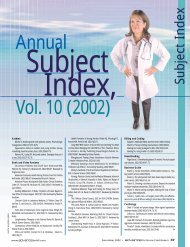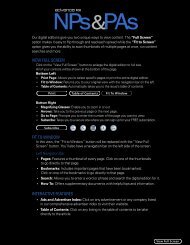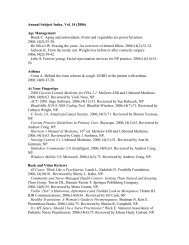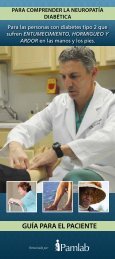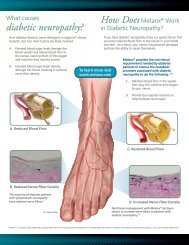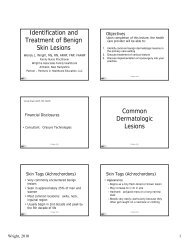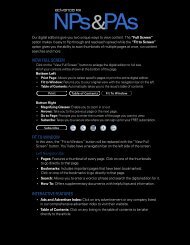Surgeryologist checks the IV line and makes sure that all preoperativemedications have been administered. He or she connects thepatient to cardiac leads and assures that the patient’s cardiacand pulmonary status are being monitored prior to and duringthe course of anesthesia. He or she attaches a pulse oximeterand blood pressure cuff and ensures that all necessary equipmentand drugs are available to per<strong>for</strong>m intubation.During the surgery, the anesthesiologist maintains an openairway, proper breathing and circulation and keeps the patientin a highly oxygenated state to administer drugs as needed.The anesthesiologist is also responsible <strong>for</strong> positioning andevaluating both the intake and output of the patient. The secondanesthesia provider is the certified registered nurse anesthetistor physician assistant anesthetist. These professionals areexperts in managing a patient under anesthesia. 6 They haveobtained graduate-level education in this area. 7,8The First AssistantNumerous types of “first assistants” exist in the OR, and theyinclude surgeons, residents, interns, medical students, familyphysicians, <strong>PAs</strong>, <strong>NPs</strong>, certified registered nurse first assistants,registered nurse first assistants, perfusionists and certifiedsurgical technologists–certified first assistants.The responsibility of the first assistant is to be the assistantsurgeon during a procedure. This requires knowledge of anatomyand physiology, surgical handling of tissues, surgical instrumentationand surgical procedures. In addition, the first assistant mustbe skilled in suture techniques, positioning, sterilization, steriletechnique, prepping and draping, pre- and postoperative care,and the use of suctioning equipment, splints and casts. The firstassistant must have well-honed decision-making skills. 9Physician assistants who specialize in surgery have a specialtyorganization, the American Association of Surgical PhysicianAssistants (AASPA), which provides continuing educationand networking opportunities. 10 The surgical PA orders tests,interprets test results and writes admitting orders, progressnotes and postoperative orders. Surgical <strong>PAs</strong> determine whena patient may ambulate or be discharged, write prescriptions,per<strong>for</strong>m discharge summaries and plan postoperative followup.11 Nurse practitioners may also function in this role.All hospitals establish criteria <strong>for</strong> who may “first assist” andon what cases. <strong>NPs</strong> apply <strong>for</strong> credentials in the same manner as<strong>PAs</strong> and must specify a supervising surgeon. For in<strong>for</strong>mationon APNs transitioning to a first assist role, see the followingarticle: http://www.medscape.com/viewarticle/499689.website <strong>for</strong> the Association of periOperative Registered Nurses,to find advice <strong>for</strong> preventing surgical site infections. Additionalguidance is available from the Centers <strong>for</strong> Disease Control andPrevention at www.cdc.gov/handhygiene/24. ■References1. Kurzweg FT. The patient, his surgeon and the record. In: The Surgeon’s Handbook.Garden City, N.Y.: Medical Examination Publishing Company , Inc.; 1982: 3.2. Position statement of the Association of periOperative Registered Nurses. OnePerioperative Registered Nurse Circulator Dedicated to every Patient Undergoinga Surgical or Other Invasive Procedure. http://www.aorn.org/Clinical_Practice/Position_Statements/Position_Statements.aspx. Accessed Jan. 23, 2012.3. Centers <strong>for</strong> Medicare and Medicaid Services. Conditions of participation<strong>for</strong> hospitals: surgical services. http://www.cms.gov/manuals/downloads/som107ap_a_hospitals.pdf. Accessed Jan. 23, 2012.4. Sweeny F. Who’s the person giving my anesthesia? In: Sweeny F. The AnesthesiaFact Book. Perseus Publications; 2003: 3-12.5. University of Cincinnati Residents, Berry S. The Mont Reid Surgical Handbook.4th ed. Mosby;1997.6. Sumpter R. Anesthesia. In: Labus JB. The Physician Assistant SurgicalHandbook. W.B. Saunders; 1998: 19.7. All about anesthesia. American Association of Registered Nurse Anesthetists.http://www.aana.com/<strong>for</strong>patients/Pages/All-About-Anesthesia.aspx. AccessedJan. 23, 2012.8. Facts about AAs. American Academy of Anesthesiologist Assistants website.http://www.anesthetist.org/factsaboutaas/. Accessed Jan. 23, 2012.9. Weis MK. The first assistant and collaborative practice. In: Rothrock JC, SeifertPC. Assisting in Surgery: Patient-Centered Care. Competency & CredentialingInstitute; 2009: 387-405.10. American Association of Surgical Physician Assistants website. www.aaspa.net. Accessed Jan. 23, 2012.11. Blumm RM, Condit D. Surgical physician assistants help solve contemporaryproblems. Bull Amer Coll Surg. 2003;88(6):14-18. http://www.facs.org/fellows_info/bulletin/2003/blummcondit0603.pdf. Accessed Jan. 23, 2012.12. Manz EA, et al. Clipping, prepping and draping <strong>for</strong> surgical procedures.Managing Infection Control. 2006;August: 84-97.Preventing Surgical Site InfectionsThere is no better manner in which to conclude this overview ofthe OR team than to focus on prevention of surgical site infections.Surgical site infections affect 750,000 U.S. patients everyyear. 12 These infections can increase length of stay in a hospital<strong>for</strong> up to 10 days. Increased length of stay adds $20,842 to theaverage patient’s hospital charges. 12 These excess charges arenow absorbed by the institution, not the insurance company.Appropriate implementation of the perioperative role canrender these infections preventable. Visit www.AORN.org, the<strong>ADVANCE</strong> <strong>for</strong> <strong>NPs</strong> & <strong>PAs</strong>37
Professional IssuesJob SatisfactionWhat makes a difference to <strong>NPs</strong>?By Rebecca Ann Priebe, MSN, ACNP-BC➼ The recruitment and retentionof nurse practitioners is an importantissue in primary care. Employers’ successin attracting and retaining qualified<strong>NPs</strong> depends on NP job satisfaction. 1 Itis beneficial <strong>for</strong> employers to understandwhat factors keep <strong>NPs</strong> in their jobs. 2PurposeThis study sought to examine factorsthat contribute to NP job satisfactionand dissatisfaction. The study exploredan array of intrinsic and extrinsic factorsusing the Misener Nurse Practitioner JobSatisfaction Scale. The specific researchquestions addressed were:1. What factors do <strong>NPs</strong> perceive ascontributing to their job satisfaction?2. What factors do <strong>NPs</strong> perceive ascontributing to their job dissatisfaction?3. Do <strong>NPs</strong> perceive intrinsic factorsas satisfiers or dissatisfiers?4. Do <strong>NPs</strong> perceive extrinsic factorsas satisfiers or dissatisfiers?5. Is job satisfaction linked with age,length of NP certification and length ofemployment?Conceptual FrameworkThe Herzberg two-factor theory is theconceptual framework that guided thisresearch study. 2 Herzberg hypothesizedthat job satisfaction and job dissatisfactionare represented on two separatecontinuums. Employees may be satisfiedwith some aspects of their jobs and dissatisfiedwith others. 2 He suggested thatfactors of satisfaction are intrinsic factors,which he identified as achievement,recognition, work itself, responsibilityand advancement. He suggested thatfactors of dissatisfaction are extrinsic;they include working conditions, interpersonalrelationships, salary, security,administration and supervision. 3In this study, I used Herzberg’s theoryto operationalize the Misener NursePractitioner Job Satisfaction Scale. Thisscale incorporates the intrinsic andextrinsic factors proposed by Herzbergto assess job satisfaction among <strong>NPs</strong>.Related LiteratureBullough 4 initiated research about jobsatisfaction among pediatric <strong>NPs</strong> at theUniversity of Cali<strong>for</strong>nia. The longitudinalstudy surveyed 17 NP students about satisfactionat the start of their program andthen 1 year after graduation. The researchdocumented no significant differencebetween the participants’ pre- and posttestopinions. All but one replied that theywere equally if not more satisfied withtheir NP role after graduation. The authorconcluded that intrinsic factors positivelycorrelated with job satisfaction. 4More recent research has identifiedspecific factors contributingto satisfaction and dissatisfactionwith NP jobs. A study byKoelbel et al. 1 used the Indexof Job Satisfaction and theMinnesota SatisfactionQuestionnaire to measureglobal, general, intrinsicand extrinsic factorsin NP job satisfaction.These researchers determinedsatisfaction to berelated to increased professionalism,per<strong>for</strong>minginteresting and challengingwork, assuming more responsibility, experiencingachievement, receiving recognition,and having potential <strong>for</strong> growth.Koelbel et al. identified factors relatedto dissatisfaction as salary limitations,poor working conditions, questionable jobsecurity, poor coworker relationships andthe constraints of policies. In this sampleof 146 <strong>NPs</strong>, the researchers reportedthat intrinsic factors were sources of jobsatisfaction, and extrinsic factors weresources of job dissatisfaction. Ninetypercent of <strong>NPs</strong> were satisfied with theirjobs, regardless of extrinsic factors.More recently, a study by De Milt etal. 5 examined the relationship betweenNP satisfaction and turnover. This crosssectional,descriptive study included 254<strong>NPs</strong> and used the Misener scale and theAnticipated Turnover Scale to analyzecurrent job satisfaction and the <strong>NPs</strong>’jeffrey leeserRebecca Ann Priebe is an acute care nurse practitioner at Pulmonary MedicineAssociates in Warren, Mich. She has completed a disclosure statement and reportsno relationships related to this article.38 <strong>ADVANCE</strong> <strong>for</strong> <strong>NPs</strong> & <strong>PAs</strong>



